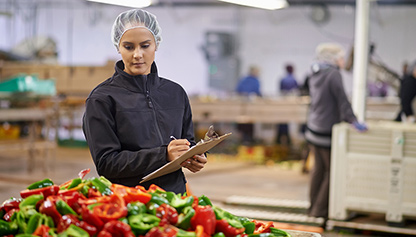Mycotoxins: A Growing Threat to Food Security in a Changing Climate

14 Mar 2025
In this blog we look at the effect of climate change on mycotoxin occurrence, potential impacts on food safety and security, and how to mitigate the risks of mycotoxins.
Occurrence of mycotoxins
Mycotoxins are naturally occurring toxins produced by certain types of fungi which grow on a variety of food types, examples of which include fresh and dried fruits, cereal crops, spices and nuts. Mycotoxins are secondary metabolites, meaning they are by-products of the fungus's metabolic processes. They can cause a variety of adverse health effects ranging from acute poisoning to immune deficiency and cancer.
Several hundred individual mycotoxins have been identified however, the most commonly reported food issues concern aflatoxins, ochratoxin A, fumonisins, deoxynivalenol and zearalenone. These have been a focus due to the severity of their effect on human health and their prevalence in foodstuffs.
The effect of climate change on mycotoxin occurrence
The fungal contamination that can lead to mycotoxin production is more likely to occur in warmer climates with greater humidity. Many fungi that produce mycotoxins, such as Aspergillus and Fusarium, thrive in warmer environments. The increase in global temperatures due to climate change has created more favourable conditions for the growth of such fungi. Additionally, an increase in incidents of unpredictable rainfall patterns has raised the mycotoxin risk in different ways.
Where heavy rain is followed by high temperatures, the resulting humidity provides ideal conditions for fungal growth. Crops like wheat and maize, for example, are particularly vulnerable to fungal contamination at elevated moisture levels. In drought conditions, crops such as peanuts and corn have their natural defences weakened and become more susceptible to mycotoxin growth, especially aflatoxin.
The changing climate is also affecting the population and distribution of crop pests, which can indirectly increase mycotoxin contamination. Insect damage to crops such as maize allows fungi easier access to plant tissues, promoting fungal growth and toxin production.
While the field conditions of crops are an important part of mycotoxin risk assessment, they are not the only consideration. Post-harvest processing, storage and distribution are also areas of the supply chain where mycotoxin contamination can occur when the conditions are favourable. The potential for fungal growth and the production of mycotoxins during production and distribution is significantly affected by temperature and humidity, elements which the changing climate has made more difficult to control.
In general, climatic changes mean that mycotoxin production has now become an issue in regions which were previously too cool to promote significant growth. The changes to environmental conditions linked to climate change have, therefore, altered the geographic risk assessment. The United Nations Food and Agriculture Organization (FAO), in a Foresight study in 2022, stated that:
“…aflatoxins, which were traditionally considered a problem mainly in tropical areas (such as in some parts of Africa), are now quite established in other geographical zones and regions (such as in the Mediterranean)”.
Increased risks to food safety and security
The changing climate has produced conditions in many regions which are more favourable for fungal growth and the production of mycotoxins. Warmer temperatures are offering greater opportunities for growth of Aspergillus (the fungus producing e.g. aflatoxin and ochratoxin) and Fusarium species (deoxynivalenol, zearalenone et al), and the World Health Organisation has identified mycotoxins as one of the food contaminants ‘of most concern to health’.
Mycotoxins can have severe health effects even at low concentrations. Exposure is commonly through ingestion of contaminated foods, although inhalation of airborne mycotoxins is an acknowledged risk in occupations such as farming and cereal processing. The risk will vary dependent on the mycotoxin involved, the exposure time and an individual’s health, however severe adverse health effects include:
- Acute toxicity causing symptoms of diarrhoea, vomiting and, in severe cases, death
- Chronic toxicity, linked to higher rates of liver cancer and suppression of the immune system
- Reproductive effects linked to infertility and developmental issues in foetuses and children
Food security may also be affected by a rise in the prevalence of mycotoxins in susceptible crops. The availability of safe, nutritious food is a primary concern for countries across the world, however climate change-driven increases in incidences of mycotoxin contamination pose significant risks to maintaining food availability.
The following are examples of how contamination can affect the global supply chain and consumers:
- Crops with mycotoxin levels above the regulatory limits may need to be withdrawn from sale, reducing available supply and placing additional economic pressure on farmers.
- Contaminated ingredients in the global supply chain may lead to the forced withdrawal from sale of large quantities of multiple products, putting pressure on supply and raising food prices.
- Mycotoxins also contaminate animal feed. Infected animals may suffer from poor health or reproductive problems. This can lead to lower meat, milk, and egg production, affecting both food availability and income generation for farmers reliant on livestock.
- Countries that rely on imports for key food staples may face disruptions in supply if major exporters experience mycotoxin-related crop losses. This can create food shortages in regions dependent on external sources, further increasing food insecurity.
Given the potentially severe effect of mycotoxins on human health, the regulatory limits are set at very low levels. For example, the current EU regulation, (EU) 2023/915, sets a maximum limit for aflatoxins in cereals and processed cereal products at 4 ug/kg. The changing climate has made it ever more difficult for food producers to consistently comply with the regulations. A 2020 study by Queens University, Belfast on the threat of mycotoxins to food safety and availability estimated that 60 – 80% of crops were contaminated with mycotoxins. An estimated 20% of crops contained levels of mycotoxins which were above the legal limits prescribed by the EU.
The United Nations Food and Agriculture Organisation has acknowledged that, unless awareness of mycotoxin risk is raised among farmers and food producers, and their processes adapted accordingly, the risk to public health and food supply is likely to increase.
Mitigating mycotoxin risk
Climate change continues to affect environmental conditions all over the world. This in turn affects food production, forcing farmers, manufacturers and retailers to reassess their vulnerability to e.g. temperature rises, increased rainfall or severe weather events.
In terms of mycotoxin production in susceptible foods, strategies to mitigate the risk should consider not just agricultural processes but all stages of the supply chain. Below are some examples of how practices can be created or adapted to reduce mycotoxin risk.
-
Crop management practices
Farmers can rotate crops or increase the diversity of plants they grow. Rotating susceptible crops with varieties that are less vulnerable can help break the cycle of contamination. Encouraging the use of crops which are naturally more resistant to fungal infections can also reduce mycotoxin risk. Considering the timing of planting and harvesting, and minimising crop exposure to the high humidity and temperatures that favour fungal growth, will also be a mitigating factor.
-
Monitoring and surveillance
Technology has improved in agriculture and can now provide options on, for example, remote optical sensing of crop quality. This can act as an early warning for signs of disease or plant stress. Sophisticated IT systems also track climate conditions and weather patterns, allowing for more informed planning of activity.
Routine field inspections are a way of early identification of fungal infection. Inspection rates can be increased at periods where climatic conditions pose a higher risk. Regular testing of susceptible crops for mycotoxins, at all stages of production, can demonstrate the effectiveness of procedures and any risk-based controls that are in place.
-
Post-harvest processing and storage
Good hygiene practices in all cases are very important. Crops should be dried properly and immediately after harvest. Mycotoxin-producing fungi, such as Aspergillus, Penicillium and Fusarium, thrive in moist conditions.
Storage facilities should have controls on humidity and temperature, regularly monitored, to inhibit fungal growth and reduce the risk of mycotoxin production.
-
Supplier management
For food manufacturers and retailers, one of the best ways to ensure product safety and quality is to work with suppliers who are certified to an international standard, e.g. Global G.A.P, or BRCGS. This will demonstrate that the supplier’s controls have been independently assessed by an auditor and found to be in line with the agreed standard.
Developing a due diligence testing plan for raw materials which are higher risk for mycotoxins will provide data to support supplier performance and identify ingredients which exceed any regulatory limits.
-
Education and training
Raising awareness of mycotoxin risk among employees is critical to ensuring that controls are effective. Businesses can develop a training plan for all relevant employees that covers best practices in reducing the risk of mycotoxin contamination. Dependent on the stage of the process to be covered, suitable training might include identification of risk and the link between mycotoxins and climate change, the importance of agricultural best practices, and how to manage storage / processing controls.
By implementing these strategies, businesses can better safeguard food supplies from the growing threat of mycotoxins exacerbated by climate change. These interventions can also help maintain food quality, reduce economic losses, and protect public health.
MORE INFORMATION
E-book: Managing Mycotoxin Risk in Food and Feed: updated February 2025


